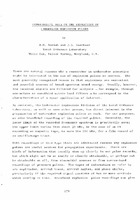| dc.description.abstract | There are several reasons why a researcher in underwater acoustics might be interested in the use of explosion pulses as sources. The most generally recognized reason is that explosions are convenient and powerful sources of broad- spectrum sound energy. Usually, however, the rec eived signals are filtered for analysis - for example, through one- octave or one- third octave band filters -to correspond to the characteristics of a sonar application of interest . By contrast , the Underwater Explosions Division of the Naval Ordnance Laboratory, as well as some other groups, has direct interest in the propagation of underwater explosion pulses as such . For our purposes, we make broadband recording of the received pulses. Generally, the lower limit of the recorded frequency spectrum is practically zero; the upper limit varies from about 20 kHz, in the case of an FM recording on magnetic tape, to more the 100 kHz, for a film record of an oscilloscope trace. | |
